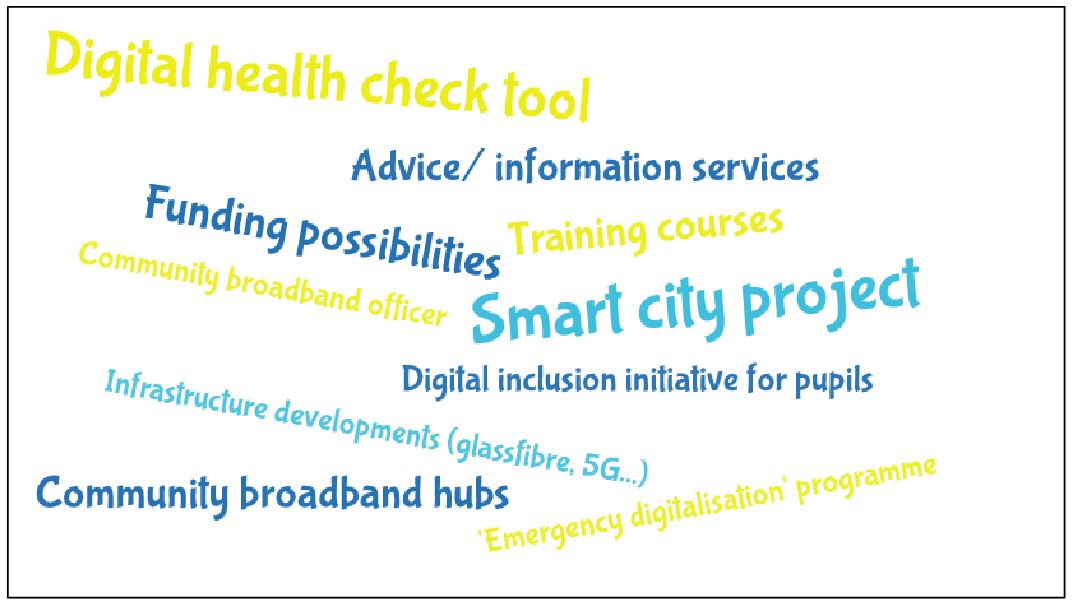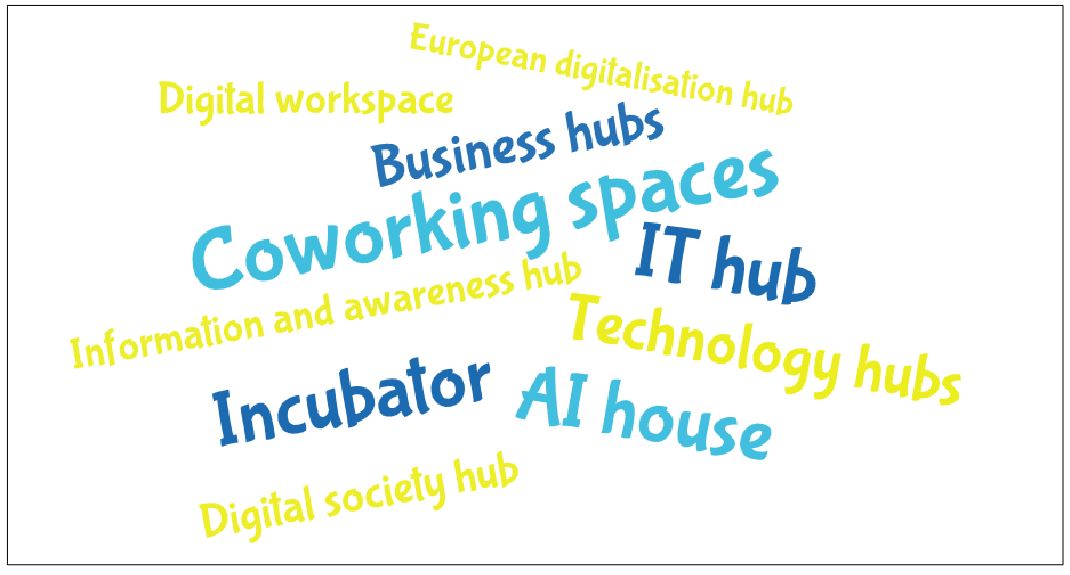Digital transformation in North Sea pilot regions
Insights from the Interreg VB COM³ project
Within the Interreg North Sea Region (NSR) project COM³, the adoption of digital technologies by businesses in the participating regions stands central. To evaluate the situation and circumstances in the different participating regions, research was conducted in the form of a survey and in–depth interviews with key stakeholders. This report presents the findings and shall support the understanding between local and regional stakeholders as well as the development of responses addressing the identified challenges.
Methodology
To facilitate the exchange of experience and knowledge among the COM³ project partners and beyond, we first developed a survey to get an initial overview of the situation in the pilot regions. This survey covered questions about the economic situation, the internet connectivity and uptake, digital literacy training available and measures of the public sector to foster digital developments. Thereby, a mix of closed and open questions was applied.
As a follow–up, the results of the survey were screened and the remaining questions were formulated by the project partners responsible for developing the training material within the COM³ project. The main subtopics hereby were questions about the development stage and support possibilities in the participating regions, regulatory support and financing schemes, questions about the development of the pilot activities, outcomes of the exchange with businesses in the region, effects of the covid–19 crisis, questions about cybersecurity and hub training. The developed questionnaire resulted in eight in–depth online interviews of one to two hours with one to two persons from the pilot regions in Belgium, Denmark, England, Germany, Netherlands and Norway. Subsequently, the recorded interviews were transcribed.
Important to mention is that the surveys were collected at the beginning of the covid–19 pandemic (February to May 2020) and the in–depth interviews took place in February and March 2021.
Survey results
Overview of regional economics
– The share of the IT sector in the pilot regions was around 2 to 7 % (but not necessarily all businesses were included as the distinction proved challenging or statistics were not available).
– Most of the survey participants indicated that the local economic performance improved over the last 5 years, one saw it rather stagnating
– The unemployment numbers laid between 1 and 5%, but one participant already indicated that the covid–19 crisis should have an impact on that
– The share of SMEs in the partner regions was mostly >90% and in one region, a share of 31 – 50% was estimated
– The share of self–employed varied: some were between 5 and 20%, some higher or even >40%
– When asking about sectors dominating the local economy, diverse sectors were named, reoccurring ones were: agriculture/ food–related, (e.g. processing or catering, aquaculture), tourism and crafts/arts, health sector (care and life sciences), manufacturing/construction (several times in general ‘industry’, engineering and textile sector named here), furthermore the following service level activities were named: trade, business services, retail. Regional
specialisations like petroleum, wind power, defence, hydropower and two times logistic sector were added
Internet connectivity and adoption
When asking about the internet connectivity and more specifically about NGA (Next Generation Access) coverage, some frontrunners were to be identified where the NGA coverage was >98% of the households. A few survey participants indicated some white or grey spots in the area.
Regarding the uptake of NGA by businesses, it was shown that there can often no differentiation be made regarding private households and businesses. Some mentioned that a part of the businesses was still waiting for an improvement of the available connectivity and one participant mentioned that the coverage is expected to be 100% NGA by the end of 2020.
Moreover, it was asked whether there are any sectors identified which are rather laggards regarding NGA adoption. Some partners responded that they do not have information on that available or stated that this is not a problem. However, a few participants noted that agricultural/ craft businesses showed to rather be laggards, e.g. not using the possibilities given for online marketing or changing business processes. Once it was noticed as well that smaller businesses in rural areas and traditional sectors such as agri-food tended to have lower uptake levels. Another survey participant added that the food and construction sector was less likely to take up NGA and that probably the size of the company / the place in the value chain played a role as well. Due to delays in broadband development, one participant noted that the transport sector in the respective region considered relocation, furthermore also the tourism and agriculture sector was impacted by these delays.
Promotion of NGA adoption
Institutions supporting the NGA uptake by businesses (and partly also by citizens) in the regions were the following: twice broadband initiatives and once a broadband competence centre were named, the telecommunication companies, but also regional authority, municipality, civic organisations, adult education centres, and open network initiatives by private parties were listed. Once it was additionally mentioned that the regional and federal government aimed at promoting NGA uptake, but that no consensus was found among the stakeholders yet on how to approach this together.
A range of activities by the beforehand mentioned support organisations were listed: fostering NGA deployment/ promoting the roll-out, offering training/ workshops and seminars, giving (financial) advice, creating general awareness, and administrative support of the municipalities.
Additionally, it was asked whether there was any online support given as well. Here, two mentioned the tech support by telecommunication companies, so rather private providers offering support for companies and professionals in that regard. Moreover, public online services were partly available as well. Once, the broadband information centre offered online services, Digi-points with computer assistants were named and one participant wrote that several services were available, for example business support systems.
Digital literacy training
When asking about institutions in the area covering digital literacy training especially for businesses/ employees, two mentioned an initiative in place or were working on that for the whole region (with educational and business support partners). One participant wrote to offer courses for entrepreneurs (through business support, e.g. also by providing start-up environments) and one referred to the chamber of commerce for digital literacy training. One survey participant still mentioned the federal government fostering citizens and companies to communicate digitally with public services and another one wrote having several institutions in the region offering courses, consultancy and research.
Accordingly, several funding possibilities were mentioned, depending on the institutions working on it: privately/ by businesses themselves, public/ EU funding, municipality, regional authority and national government were listed.
We also asked how far these support mechanisms were used in the way it was expected. No clear answer was given regarding that, as it was either not known, not done yet or not observed as being a problem. Moreover, it was added that in one region, the fragmentation of government bodies was generally observed as a problem, leading to a loss of time, budget, misunderstanding and incompatibility
Regional/ local digital agenda
We were also interested in whether there is a local/ regional digital agenda in place. Two mentioned being currently working on it. Two other participants explained to rather act straightforwardly: they had the goal/ focus to foster digitalisation in the region but no specific action plan in place. One participant was mainly focusing on providing NGA for a fair price and increasing the collaboration. In one region, there was no agenda yet, but the plan existed to still make one. In another survey response, it was elaborated that the digital agenda consisted of the provision of similar services to all municipalities and the focus on different strategy levels such as a web platform etc. Finally, for one region, it was indicated that a digital agenda was of relevance already some years ago and that in the meantime, the region can be seen as already well developed, making a digital agenda redundant.
Room for improvement regarding NGA adoption and digital literacy training
When asking where the survey participants would like to see improvements in the region regarding both, NGA connectivity/ adoption and digital literacy training, we received the following answers regarding connectivity:
– improve connectivity to achieve 100% NGA coverage
– further focus on the deployment of NGA due to commercial parties working against each other
– rolling out open networks
Regarding digital literacy:
– seen as a big challenge to foster it in order to also draw advantages of digital tools and possibilities
– bringing together fragmented initiatives
– similar to above: connecting and broadening existing initiatives
– working on an action plan to improve digitalisation in the municipality and aiming for a growth and development strategy
Key findings/ messages from in-depth interviews
Regional overview
Level of digitalisation among businesses in the regions
- Mixed impressions found in the pilot regions regarding the average level of digitalisation among businesses
- Remarkable differences between businesses in a region to be observed (e.g. depending on size and business model)
- Level of digitalisation was also brought in relation with the state of the digital infrastructure
Digital technologies/tools used by businesses
- Among and within regions remarkable differences when asking to what extent digital technologies are adopted by businesses of a regionssions found in the pilot regions regarding the average level of digitalisation among businesses
- It depends on the degree of digital adoption one refers to, e.g. having a website or the usage of digital data (the more advanced the adoption level, the higher the chance of an adoption gap among businesses)
- Smaller retail businesses are rather seen as laggards in that respect, but not to be generalized
Crucial stakeholders
- Business support initiatives were named as key stakeholders also supporting businesses in their digital transformation processes
- Some other public and private organisations were listed
Public support measures
- Focus on the provision of suitable infrastructure named as a public support measureds
- Several times public funding mechanisms were mentioned, but also other public initiatives beyond financial support were listed as well

Sector-specific relations
- No clear sector-specific differences were to be identified
- Rather regional focus on key sectors to take into account
Public vs. private offers
- No clear Whether public or private solutions are used by businesses depends on the kind of support they wish for
- Bigger companies are rather found to have resources for external experts and similar
Rural businesses
- Partly rural-urban adoption differences noticed, depending rather on the focus of the business
Regulatory support and financing schemes
Regulatory support and financing schemes
- Various financial and regulatory support mechanisms listed
- Some, rather smaller businesses struggle to make use of support mechanisms
- Platform for bundling support offers and improve communication suggested
First effects of Covid-19 crisis
- Less mobility during the lockdowns and partly change of location to work or even live observed
- Some sectors more affected than others, partly impacts on employment weren’t as bad as expected at the beginning of the crisis
Digitalisation-related
- Several and diverse initiatives initiated during the covid-19 crisis
- Occasional limitations in internet speed experienced
- Partly, the crisis boosted the general awareness of and switch to digital alternatives

Digital hubs
Physical hubs
- At least in surrounding of the pilot regions hubs to be found
- More often business–focused (coworking, incubator…)

Covid-19 influence
- Generally, the usage of physical hubs was negatively affected by the covid–19 crisis
- Responses to the covid-19 crisis were found in physical hubs as well
Online hubs
- No ‘typical’ online hub in any of the regions established
- However, online support/exchange mechanisms can be offered by regional stakeholders
Cybersecurity
Regulatory support and financing schemes
- Various financial and regulatory support mechanisms listed
- Some, rather smaller businesses struggle to make use of support mechanisms
- Platform for bundling support offers and improve communication suggested
Cybersecurity awareness among SMEs
- Level of awareness among businesses differs
- Cybersecurity tends to be neglected
Main challenges identified
As shown in the previous chapters, the circumstances and conditions in the various pilot regions partly differ. Still, we identify the following major challenges found in some cases:
- For fostering digital literacy or in general uptake of digital solutions, fragmented initiatives were mentioned as a challenge
- Sometimes there is no complete overview given regarding activities/ stakeholders in the field of digital initiatives, several times it was wished for better exchange/ collaboration possibilities (also partly businesses wishing for that)
- Regarding cybersecurity a strong reliance on experts/ cloud providers was found, some businesses underestimate the risk or the resources to improve cybersecurity are missing
- Especially smaller businesses partly missed overviews regarding their progress in digitalisation efforts compared to other businesses or tending to not make pro– active changes, rather sticking to business as usual if possible (long–term perspective neglected)
- Regarding funding and regulatory support partly found as being a too scattered landscape when trying to find the right funding, further a hurdle to apply for funding, especially when again resources (human and financial) are missing for it
- Some businesses hard to be reached with public support measures in general, therefore also sometimes rather the ‘usual suspects’ making use of it (also more traditional businesses located in remote areas sometimes expected to be rather reluctant to offers)
- Covid–19 crisis as an additional challenge affecting all regions, resulting in additional pressure on some businesses
- Even when awareness is on the rise regarding digital technologies and their potential among businesses, it is found as a challenge to identify what is exactly needed/ how to best approach it
- Partly, the improvement of the internet connectivity/ progress of especially glass fibre developments was still a topic for some remote places in the regions
- Instead of sectoral differences or based on the rurality of a business location, the size of companies was several times put central determining the degree of digital technologies used in business processes and beyond (some exceptions are startups and other small businesses specialised in or focusing on digital solutions)
Final remarks
While our research findings give a first impression of the digital business landscape in the pilot regions, we want to stress at this point that there is most likely no complete overview for each of the regions given. One of the reasons for that is that we cannot expect the survey and interviewees to possess knowledge about all existing activities and initiatives within the regions. Moreover, sometimes no hard data/ statistical information was available. Rather, interviewees and survey participants provided us with impressions and their individual insights. Therefore, we have also not attempted to create any regional/ national profiles. Still, we are convinced that the findings presented in this report can be helpful for local and regional public authorities based in the North Sea Region and beyond.
Some good examples and possible solutions were already indicated throughout this report. However, we were not able to take a closer look at these within the scope of this research. As a follow–up, training material will be developed, combining the input we have received from this project study with existing information and other project outputs. Next to that, the pilot activities will be closely monitored and all lessons learned from these reported as well.

